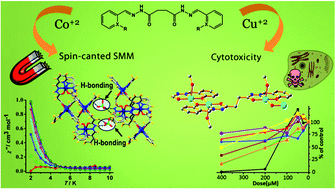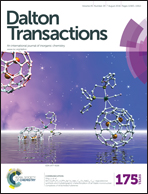Synthesis, structure, magnetic and biological activity studies of bis-hydrazone derived Cu(ii) and Co(ii) coordination compounds†
Abstract
Four coordination compounds of formulae [CuII2(H2L1)(HL1)](ClO4)3·H2O (1), [CuII2(H2L2)(CH3OH)2](ClO4)2·2CH3OH (2), [CoII2(H2L1)2](ClO4)4 (3) and [CoII2(H2L2)2]·2H2O (4) were synthesized via self-assembly of succinohydrazone derived ligands (H2L1 = N′,N′-4-bis(2-pyridyl)succinohydrazide, H4L2 = N′,N′-4-bis(2-hydroxybenzylidene)succinohydrazide) and Cu2+ and Co2+ ions, respectively. The compounds were characterized by crystal structure determination, magnetic measurements and biological activities. Compounds 1, 3 and 4 have discrete double helicate structures, whereas compound 2 is a one-dimensional chain. Magnetic studies show antiferromagnetic exchange interactions in 2 with a J value of −67.1 cm−1 and antiferromagnetic spin-canting in compound 3 originates through supramolecular H-bonding. For compound 3, a clear bifurcation was observed in zero field cooled (ZFC) and field cooled (FC) measurement at a temperature of 3.5 K and field of 0.1 T, implying long range magnetic ordering below this temperature. Interestingly, all of compounds 1–4 show significant changes in their absorption (hypo- and hyperchromism) in the presence of SS-DNA, inferring interaction between the compounds and DNA. In addition, compounds 1–4 significantly exhibited nuclease activities on both RNA and pUC19 plasmid DNA. Moreover, the nuclease activity was further enhanced in the presence of oxidant (H2O2) and suggests the possible role of reactive oxygen species in DNA nicking ability of compounds 1–4. Furthermore, compounds 1, 2 and 4 exhibited significant cytotoxicity against mammalian cancer cell lines (HeLa, A549 and MDAMB-231). In addition, our results from Annexin/PI staining and DNA fragmentation assays revealed that these compounds are capable of inducing apoptosis and have potential to act as anticancer drugs.


 Please wait while we load your content...
Please wait while we load your content...